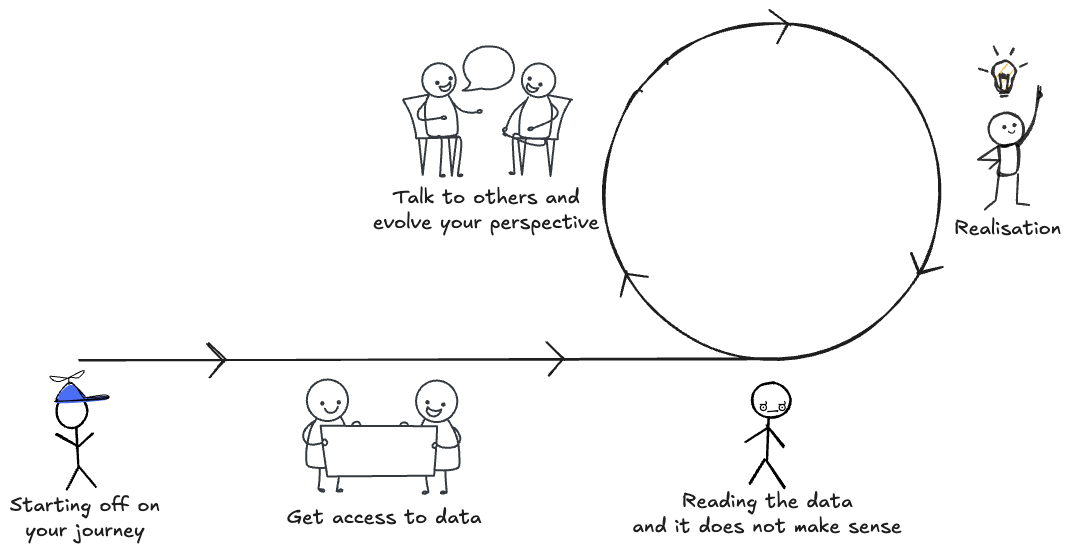Why most people believe they want transparency — but actually don’t.

Transparency has been a cornerstone of Sahaj throughout my journey here. It is not just a value we champion but a principle deeply embedded in how we operate. But transparency is not as simple as it sounds — it comes with its own challenges and costs.
Examples of transparency include sharing all business related data openly internally such as salaries, revenue, forecasted incoming work and people etc.
Transparency promotes empowerment
Trust is essential at Sahaj. We believe in empowering everyone to help our business grow by making informed decisions. For this to work, everyone must have access to the vital information that shows them the bigger picture. We strive hard to avoid informational hierarchy, where some people have information and others don’t. We believe everyone has the right to access key information, which will make people see the bigger picture and make the right decisions to help grow the business.
Having access to this information along with the power to make important decisions to grow our business is how each of us walks the path toward becoming better CEOs and business leaders. Consequently, some of us (myself included) experience an increased sense of fulfilment and engagement. It enables each one of us to articulate our ideas, grow and build expertise in the areas we would like to while simultaneously helping our business grow. However, this empowerment also comes with responsibilities and challenges, as transparency requires effort and understanding to truly benefit the collective.
Balancing collective and individual needs
Transparency, like any valuable principle, comes at a cost. Informational transparency makes information available to everyone. While the context is provided internally, everyone will not have spent the same time to absorb and process the information on their end since their priorities are different. Broadly, folks primarily responsible for operations (business oriented roles), spend more time thinking about these things than folks primarily responsible for software delivery.
Transparency, like radical candor, requires looking beyond initial reactions to understand the deeper context. Let us understand this with an example.
An example through personal experience
Let’s talk about open salaries. The concept is simple, ensure that everyone inside the organisation knows how much everyone else makes. We do this to make sure everyone in the organisation gets paid appropriately. For me, personally, it has made it possible to spend less time worrying about whether I get paid fairly and more time in actually doing my best work.
On day one, transparency might feel overwhelming — like staring at a spreadsheet of numbers without context. As one spends more time in the organisation, understands contexts and the value an individual brings in, they are then able to better co-relate the number with value. At this point, a lot of things start making sense like why I get paid what I do and why others around me get paid a similar amount. There will also be a ton of things that will not make sense. This is a pivotal point because either I could make assumptions or ask for clarification. Assumptions often lead to frustration, a path I prefer to avoid. Much like many other Sahajeevis, I took the route of asking for more information. Sahaj is a pull-based organisation meaning we expect people to ask questions whenever they have them and those with more context will provide it. Over time, as you engage and ask questions, patterns emerge, and you start to see the bigger picture.
At some point, you will interview a candidate you really like. However, based on your understanding of how salaries work internally, you might think this is an offer we should not make (usually because their expected salaries are too high). You know there are internal mechanisms to handle such situations. Despite having “similar knowledge”, some of us will be comfortable moving forward and some of us will not. There are a couple of reasons why people react differently to the same information.
They are comparing the candidate to themselves.
They are unable to see the bigger picture, either because they haven’t fully understood the information or because they cannot see past self interest (#1)
True cost of transparency
When people understand the larger picture and prioritise the collective over immediate self-interest, transparency transforms from a burden into a powerful tool for running an effective business. This balance between discomfort and long-term growth is the true cost — and reward — of transparency.
While many people believe they want transparency, what they often seek is convenience. Convenience to have access to data and to be able to use it to make arguments that serve their self interest. This is a normal part of the journey we all go through in transparent organisations.
The true reason for needing transparency in an organisation is to help teach all of us how to effectively run a business. This requires us to be uncomfortable at times. Uncomfortable because we need to put a collective (our business) before ourselves. Uncomfortable because we have to admit the fact that at times, we want to think of ourselves first and that, as leaders, there are times we cannot or should not. Uncomfortable with the realisation that while we might want to be leading our business, there are moments when we aren’t ready to do so. What we all want at times is just comfort and to not have to think of the big picture.
When we join an organisation like Sahaj, we get access to information. At some point, the information will not make sense to us (based on our context, available information and/or knowledge). The only way to grow is to start a conversation with others and evolve our perspectives, which drives us to realisation. This state of confusion isn’t permanent since we will eventually realise new unanswered questions which require growth in our perspective.

The journey from induced despair to realisation
What transparency really requires is the effort to go on this journey of learning and growth.
Embracing the Challenge and Growth of Transparency
Transparency grants us access to important information, which challenges us to think critically and grow both personally and professionally. However, this growth often comes with moments of discomfort —times when we must confront opposing viewpoints or accept hard truths. And that’s okay. It’s okay to feel uncomfortable, to need time to process, and to engage in open dialogue to navigate these complexities.
The rewards of transparency are profound: freedom, greater knowledge, continuous learning, and meaningful growth. Yet, the cost of transparency is equally real. It requires us to embrace discomfort, confront differences, and invest time in understanding and resolving them.
If you find yourself wanting transparency but hesitating to embrace the effort it demands, perhaps what you’re truly seeking is convenience — the comfort of data that reinforces your own perspective. There’s no shame in admitting this; I, too, have found myself drawn to the easier path at times. It’s human nature. But real progress, like radical candor, requires a willingness to embrace discomfort and challenge ourselves to change.
Transparency is not just a value — it’s a practice. It asks us to think beyond ourselves, to see the bigger picture, and to lead with empathy and understanding. If we’re willing to pay its price, transparency can transform not just our organisations but also ourselves as leaders and contributors to a collective vision.
Thanks to Kshitij, Swapnil, Puneet, Geeta, and Priyank for their reviews and early feedback.



